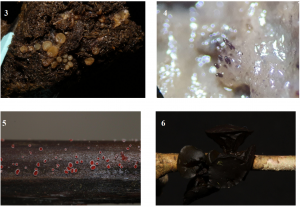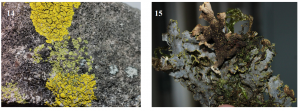Course and Discipline Diversity of Ascomycota Macrofungi

The research group MIND.Funga and the PPG in Biology of Fungi, Algae and Plants (PPGFAP) from UFSC held the course and discipline “Diversity of Ascomycota Macrofungi”, with practical activities in altitude ecosystems from Urubici/SC. The event took place from 28th november to 02nd december and had the support of INCT Virtual Herbarium of Flora and Fungi, PELD/BISC, MIND.Funga PRONEM/FAPESC, ICMBio (PARNA São Joaquim), The New York Botanical Garden and PPGFAP /UFSC.
Under coordination of Prof. Elisandro Ricardo Drechsler-Santos (MIND.Funga/MICOLAB/UFSC) the event (discipline and course) counted with the presence of 4 taxonomic specialists from different groups of Ascomycota, Dr. José Luiz Bezerra (State University of Santa Cruz, UESC/Bahia), specialist in phytopathogenic and saprophytes ascomycete fungi, Dr. João Araújo (New York Botanical Garden, NYBG/USA), specialist in entomopathogenic ascomycete fungi, Dr. Francisco Calaça (State University of Goiás, UEG/Goiás), specialist in coprophilous ascomycete fungi and Dr. Adriano Afonso Spielmann (Federal University of Mato Grosso do Sul, UFMS/Mato Grosso do Sul), specialist in lichens.

Participants of the event gathered at the accommodation of ICMBIo in the São Joaquim National Park. From left to right standing upright: Jorge, Suzana, Leena, Olavo, Bezerra, Francisco, Cristiano, Kelmer, Funez, Rodrigo, Eloisa, Genivaldo and Juliano – lowered: João, Quimi, Daniel, Denis, Weslley, Larissa, Matheus, Iolly, Zoe, Adriano and Ricardo.

Place of origin of participants.
In total, the event had 17 participants (6 students enrolled in the PPGFAP/UFSC discipline and 11 as course participants), representing a heterogeneous group of people and professionals related to mycology. Coming from different institutions, we had colleagues from 3 countries (Brazil, United States of America and United Kingdom), with Brazil having the largest number of participants, coming from 9 states (AM, BA, GO, MS, PR, RJ, RS , SC and SP), representing all regions of the country.
Main activities and results
Collection: field trips to collect macrofungi in permanent plots and cloud forest fragments in PARNA;
Guidelines and good practices in the field: how to collect specimens and their respective collection data, how to photograph;
Guidelines and Post-field good practices: how to process samples for dehydration, how to manage data for a safe and curated base, including photographs, and how to perform macro and microscopic morphological analyzes for specimen identification;
Classes and seminars: both professors and students will present content related to good practices or novelties resulting from the studies carried out;
Assembly of physical and digital Fungarium.
Identified collections and taxa
In total 258 specimens were collected, totaling 101 species distributed in 50 genera. Altogether, 125 specimens are lichens, 75 saprophytes, 26 phytopathogens, 21 entomopathogens and 11 coprophiles. Many of the collections represent scientific novelties, being new records for Santa Catarina and/or Brazil, or yet new species for science.

Distribution of the 258 specimens collected among the identified functional groups.
Possible taxonomic novelties
Two coprophilous species of genus Ascobolus (Ascobolus cf. lineolatus and Ascobolus cf. stictoideus), both found in puma waste ( lion baio- Puma concolor), with morphology under analysis to describe them as new species to science (Figures 3 and 4).
Among saprophytes, Erioscyphella sp., Cordierites sp. and Ionomidotis sp. and, the phytopathogen Caliciopsis cf. clavata, are candidates for new species to be described, depending only on more detailed molecular and morphological phylogenetic analyzes for comparison with the already known species of these genera (Figures 5 to 8).
While for entomopathogens, several new species already confirmed and/or in morphological and molecular confirmation of fungi that attack ants, such as three species from Ophiocordyceps unilateralis complex. Ever heard of zombie ants? So, one of these species of fungi was nominated in a public contest as O. zombifica nov. prov., which will be given to the new species that is in the process of being published. Still, there are other new species that attack flies, mealybugs, harvestmen, among others that were collected in the PNSJ (Figures 9 and 10).


New species collected in PNSJ. 3-4. Coprophiles: Ascobolus cf. lineolatus and Ascobolus cf. stictoideus. 5-7. Saprophytes: Erioscyphella sp., Cordierites sp. and Ionomidotis sp. 8. Phytopathogens: Caliciopsis cf. clavata. 9-10. Entomopathogens: Ophiocordyceps aff. unilateralis and Ophiocordyceps aff. dipterigena.
New records for Brazil
Were found fungi of the genus Ionomidotis sp. and Cordierites sp., which had not yet been recorded as occurring in Brazil, whose species may be new taxa for science, but depend on further studies (Figures 11 and 12). Another new record for the country was Scutellinia setosa, recorded growing on decaying wood (Figure 13).


Fungi collected in PNSJ new records for the country. 11. Ionomidotis sp. 12. Cordierites sp. 13. Scutellinia setosa.
New records for Santa Catarina
The species Candelariella sp. and Podostictina encuensis and entomopathogenic fungus Ophiocordyceps camponoti-rufipedis so far have no record of occurrence in the territory of Santa Catarina (Figures 14 to 16).


Fungi collected in PNSJ new records for state of Santa Catarina. 14. Lichens of genus Candelariella. 15. Lichens Podostictina encuensis. 16. Entomopathogenic Ophiocordyceps camponoti-rufipedis.
State of the art of macrofungi from PARNA São Joaquim
Although studies with scope on the Funga of São Joaquim National Park have already been carried out (Kaipper et al. 2016, Bittencourt 2019, Alves-Silva et al. 2020, Cardoso 2022), only the last one dealt with species of Ascomycota, which cited 19 species as occurring in cloud forest region of Aparados da Serra Geral, which also includes São Joaquim National Park. The unique study focused on Ascomycota carried out in the area was the dissertation by Nardes (2022), focusing on entomopathogens, which registered the incredible number of more than 30 species for the area.
Knowing the scarcity of studies with macrofungi of the phylum Ascomycota in Brazil in general, a discipline focused on the group where it was possible to bring together four of the greatest specialists in the group from Brazil and even abroad, it is certainly a memorable feat that greatly added to the knowledge of these organisms, since it aroused the students’s curiosity allied to students’s expertise in an immersive way in one of the most threatened ecosystems of Brazil. Just with this punctual field event, almost 260 specimens were obtained, totaling more than 100 species of Ascomycota fungi. This represents at least dozens of times the currently known number of species in this group of fungi for the locality. This is a great leap in knowledge given in a short period of time.
References
Alves-Silva, G., Reck, M.A., da Silveira, R.M.B., Robledo, G.L., Góes-Neto, A., Drechsler-Santos, E.R. 2020. The Neotropical Fomitiporia (Hymenochaetales, Basidiomycota): the redefinition of F. apiahyna s.s. allows revealing a high hidden species diversity. Mycol Progress 19: 769-790
Bittencourt, F. 2019. Fungos Poliporoides das Vegetações de Altitude do Parque Nacional de São Joaquim, Urubici/Sc, M.Sc Dissertation, Universidade Federal de Santa Catarina, Florianópolis, Brazil. 149p. Cardoso, T.K. 2022. Diversity and Conservation of Macrofungi from the Aparados da Serra with an emphasis on forest ecosystems. M.Sc Dissertation, Universidade Federal de Santa Catarina. 154p.
Kaipper-Figueiró, G., Robledo, G.L., Reck, M.A., Góes-Neto, A. & Drechsler-Santos, E.R. 2016. Antrodia neotropica sp. nov. (Polyporales, Basidiomycota): a new South American species of Antrodia ss from Brazil based on morphological, molecular and ecological data. Nova Hedwigia 103(1-2): 125-143.
Nardes, W. 2022. Diversidade de fungos entomopatógenos (Hypocreales, Ascomycota) no Parque Nacional de São Joaquim, Santa Catarina, Brasil. M.Sc Dissertation, Universidade Federal de Santa Catarina.







